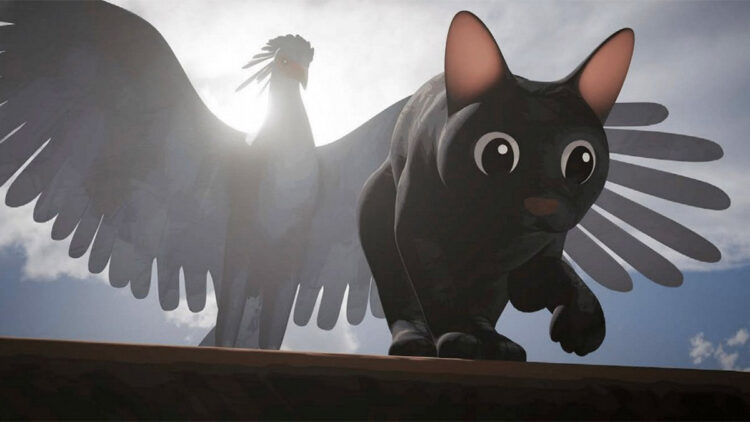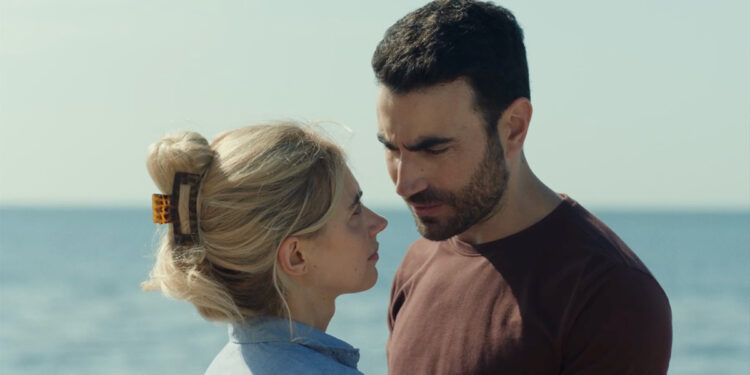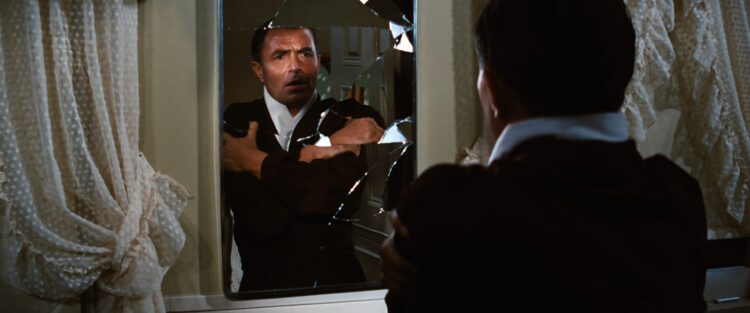

Latvian animator Gints Zilbalodis’ new wordless animation Flow looks to provide an alternative this holiday season (and awards season) to audiences seeking family fare without the chattiness and slapstick typically associated with the medium. Already a festival darling and possible Oscar contender, Zilbalodis’ film uses wide-angle compositions of lush saturated colors with naturalistic lighting and camera movements to follow a troupe of realistically-proportioned animal survivors on an ark-like boat through an apocalyptic flood, a journey that challenges them to overcome their Darwinian instincts for the sake of collective survival. (If this sounds a little bit like this year’s much more Hollywood-standard CG animated contender, Dreamworks’ The Wild Robot… well, you didn’t hear it from me.)
As the film opens in theaters from Sideshow and Janus Films, we caught up with Zilbalodis at Criterion’s Manhattan office to discuss the idiosyncratic balance of exaggeration and realism in his nonverbal cartoon animals, the ways his experiential CG narrative work is inspired by and different from VR films and video games, and some of the more cryptic story points in the film’s at times surreal scenario. Be warned that this interview contains spoilers.
The Film Stage: Compared to Hollywood-style animated films with animal characters, you’re obviously making some different calculations about how anthropomorphic the animals should be [in Flow]. Your animal characters don’t talk, and the character models for the most part are photorealistic. The animals are still given anthropomorphic qualities, however, with human-like facial expressions and behavior throughout the film. What made this a film about animals for you, and what decides when you pursue animal realism or break from it?
Gints Zilbalodis: Well, all the films I’ve done so far are without dialogue; in this case I wanted to tell a story about animals behaving like animals. They’re not speaking; they’re not telling jokes. But we’re not making a documentary, either––we’re telling a story. So we try to keep it as grounded as possible––we looked at references for all the animal behavior––but we’re not just copying nature; we’re interpreting it and creating a performance. I think in the beginning of the film [the characters] are more animalistic, but as the story develops and they get into the boat, it [was important for me] that these characters have agency. Through their decisions we understand their character and their behavior, what they stand for and what are their beliefs, so they must be able to make these decisions. It’s also a personal story for me: I wanted to show how this cat learns to work together [with others]. It’s not just the cat; those are my experiences. We didn’t have a plan or a set of rules about how they should behave; it was quite instinctual. It’s about trying to find a balance of keeping [the animals] believable, but also telling a story.
I think we’ve seen those anthropomorphic characters before, and usually if we do see animals behaving like animals they’re not the main characters. To focus on characters like that feels fresh. Maybe producers are afraid to take the risk of an animal like that being the main character; I don’t know what’s the reason why it hasn’t been done so much, but maybe because we’re a smaller, more independent kind of film we have the freedom to tell a story like this.
The narrative of semi-anthropomorphic animals sans dialogue reminded me a little bit of Fantasia, though of course in Fantasia the narrative is totally in thrall to the music, whereas this film is driven by wordless character development.
Music is a big part of Flow as well. Because there is no dialogue I think we can use other tools more, be more expressive with music and sound [design] and even the animals’ voices. Even though there’s no dialogue, we do have voices for these characters, and they’re real animals––they’re not human [actors] mimicking animals. Our sound designer is almost like an actor: he has to think about the motivation and psychology of the characters and create a performance. It’s not just technical work but very creative. We understand the characters through the environments as well, which are not just decoration but are helping us to get a peek inside heads; and the way they’re framed, if we see it from a wide angle or a profile shot, all these decisions are very deliberate. You’re not supposed to think about it––hopefully it’s subconscious for the audience––but it’s all there for a reason.

Gints Zilbalodis
Given some of the imagery in the film–-apocalyptic floods, characters magically ascending into the sky, things like that––many people will be tempted to read the film allegorically, as being about climate change or politics or religion. I’m curious to what degree there was a sense of symbolism or message that was consciously integrated into the film. Did you approach it with a scenario or allegory in mind to begin with, or did those things sort of emerge from the process?
Probably more the latter, where they emerged organically. I start with the characters and think about the relationships of these characters and everything is built around them. I thought of this story of a cat, whose fear of water is so universal it doesn’t need to be explained, and then the idea of a flood seemed like a natural way of showing these fears. I never start with a message; I think when you start with that you risk being kind of didactic or simplistic in how you convey the message. But if you start with the character and allow these ideas to emerge organically, it doesn’t feel preachy or forced.
I’ve met many people who are sure that Flow is about a certain thing––like, they’re absolutely sure––and I think it’s because we do leave certain things for interpretation. I think it’s interesting how different people with their own views see their own experience in the film. I usually don’t comment on what my interpretation is, even though I have one. For me it’s more about creating an experience than sending a message; it’s about putting you inside this world and making you feel like you are this cat and going on this journey. We present these conflicting ideas with no easy solutions––for instance, the cat learns to be more trusting in the film, but the dog learns to be more independent and less-trustful––and we let you think about what you would do in this situation.
Regarding animal behavior and animals changing, I’m curious: do you live with animals in your day-to-day life?
Well, this story was inspired by a cat I had when I was in high school, who already inspired another short film of mine. I’ve already had two dogs since then who were the inspiration for the main dog characters in this film. Right now I’m traveling so much that I don’t have any pets, but I visit my parents and their dog every once in a while. I’d love to hang out with a capybara as well, but that’s less practical. I love animals; my next film is about people, but there are still some animals as well.
As the owner of a black cat myself, and on the topic of how much realism is too much, I have to ask about something that stood out to me, and this might be an unusual question for this venue… how seriously did you consider including the cat’s butthole in the character model? Because that’s something that cats show you a lot.
[Snorts] Well, uh, we didn’t think about it that much… yeah, this character is very discrete, so we don’t see that. Maybe, as a cat owner, you might think about that… I guess there are a lot of cat owners… but that’s not what I’m interested in. I’m trying to do what most animated films do and not focus on that.
Between this film and your first feature Away, the impact of video games on your work strikes me very strongly. Between the two of them, I feel like I could make a whole list of fairly specific games whose influence came across––rather than naming names, though, I’m curious to hear from you which games, if any, you consider most influential on your work.
Some of my favorites are the works of Fumito Ueda, probably.
I definitely saw that.
I don’t know what else. It’s a bunch of games I played when I was growing up––that’s when you’re most [easily influenced] I guess. It’s about telling stories without dialogue through the environment, conveying a sense of history to this world and allowing the audience to figure it out themselves without actually using words. Letting the audience be like a detective in the story, finding these clues and trying to piece together what happened themselves. It’s about creating this immersive feeling that you are this cat… I feel like, in films, you can achieve this even more than in games because you’re also telling a story and you can push certain emotions further. You have close-ups––unlike video games where the camera follows the characters from afar––and you can see their faces and nuance in the performances.
But yeah: I’m influenced by a bunch of things in this case––video games and live-action and animation––but I’m not really consciously referencing anything. They’re just part of who I am, I guess.
The directors of the CG-animated movie Final Fantasy VII: Advent Children once described their film, which used the same technology as the cinematic assets for their games, as a piece of “non-interactive software.” As someone who is storytelling in 3D animation using modeling, shading, and rendering techniques that are comparable to what’s used in games, what do you consider the fundamental difference between these mediums? Would you ever want to work outside of animated film?
Well, even though we have these long shots and these wide-angle lenses in everything, if you were to move the camera a little bit in Flow and see what’s happening outside the frame, it’d look kind of broken. It doesn’t work. Everything is designed specifically for what you see in the frame. We can fine-tune things and we don’t have to worry about allowing the audience to see from different angles. Maybe this applies more to VR than video games, but when the audience can look around wherever they want… a good analogy would be: it’s like a buffet where you can choose what you eat.
In cinema I like, there’s a chef who prepares a dish for me and takes me on this journey and I can sit back and see this point of view. I like giving up my control as well, when someone really takes care of the experience for me. That’s what I prefer about films over something interactive. To me, making films is already so complicated, I can’t imagine adding another layer of complexity with interaction. So I think I’m gonna stick with making films for now because I feel like I’m still learning how to do that.
My last question is a bit more text-level, about the plot of the film. Toward the end, the wounded… I believe it’s a secretarybird?
Yes.
The wounded secretarybird who helped the protagonists appears, to my eyes, to be sort of Raptured to Heaven by some divine force when it’s about to die. Then, in the final scene, you see this beached whale who also helped the heroes, but the whale just seems to die without any divine intervention. I’m curious about the significance of this and what the magical or divine element that appears exclusively in that one scene in the film signifies to you.
Actually, there is a pretty important scene after the credits…
Yeah. Is that supposed to be the same whale, or are those different whales?
[Laughs] I’m not gonna say that. But yeah: the significance is, I don’t know… explaining things shouldn’t be the main goal. The cat in this film is always running away from problems. When something bad happens it always climbs up somewhere, and when the flood hits it climbs up in its house and waits for the problems to go away, and of course they don’t. Later the animals are fighting in the boat, and the cat climbs up on the boat’s mast and the problems are still there. Finally they climb up on these towers and get kind of detached from reality… they escape their problems but they also escape everything else. They lose their connection with this world, and the bird maybe has kind of given up on its hopes, feels abandoned, and doesn’t have anything else to fight for. But it doesn’t want the cat to make the same mistakes it has and it forces the cat to go back down, and the cat kind of realizes that, yeah, there’s maybe a point to that.
But yeah: that’s the cat’s journey, that it realizes that it needs to go back to reality, and maybe the bird has kind of lost that hope. With the whale, we see the flood receding and I wanted to have these complicated choices and dilemmas. When it’s a good thing for one character, maybe it’s not so good for the other characters. So when the flood goes away the cat is saved, but maybe some other characters get in trouble for that. The whale kind of represents the fears the cat has, but it kind of accepts them and accepts this intimacy with the whale, which is why I wanted to put it there.
Do you see the scene with the bird as being religious?
I don’t know, it’s maybe more spiritual… the emotion is more important than referencing anything, really. It felt to me like that was how the relationship should evolve and peak at that moment. It was the music that really guided me in that scene, because I write the music as I write the script and it helped me understand what I felt I wanted to convey. If I could explain these things with words I would not be making films; I’d just write a book. I make films to convey these emotions through images and sounds, and I feel like if I need to explain these things then I kind of failed, like a comedian being asked to explain the joke. So I kind of want to leave this unexplained… well, I think I explained quite a bit. But that’s as much as I can tell.
Flow is now in limited release.
The post Flow Director Gints Zilbalodis on Animating Animals, Allegories, and Cinema vs. Videogames first appeared on The Film Stage.



